GREELEY — Thirteen minutes.
That’s how long it would take a Logan County Sheriff’s deputy to get to Fleming’s one school if the call of an active shooter came in.
That’s assuming the deputy is in Sterling and that he’s driving 100 miles per hour.
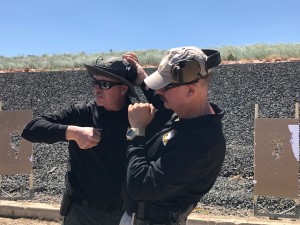
“They’ve told us that 7-8 kids are shot per minute in the average school shooting,” said Scott Muller, president of the Fleming School District Board of Education.
The entire K-12 population of the rural Colorado school district is 200.
If the deputy happens to be on the other side of Logan County, it could be 35 minutes or more before law enforcement arrived.
“Whether it’s a rural school or an urban school, in a lecture setting or recess setting, there are a lot of kids in a confined space,” said Fleming Superintendent Steve McCracken. “We want them to know they are safe.”
Muller and McCracken were two of 17 teachers, bus drivers, janitors and other administrators or school staff members taking part in the first Colorado Faculty/Administrator Safety Training and Emergency Response (FASTER) course.
The participants came from several school districts across the state. Some districts have been open and vocal about their decisions; others have made the decision in executive session and have not gone public to protect the teachers and staff who have volunteered for the program.
Complete Colorado will not identify schools, districts or employees in those districts who have asked to remain anonymous.
The three-day course took place at the Weld County Sheriff Office training facility in east Greeley. Weld officers did not help with the training but Weld Sheriff Steve Reams partnered with the organizers of FASTER to use the facility.
The class accepts no more than 24 students. Laura Carno, who organized the training though her organization Coloradans For Civil Liberties, said she had more than 24 registered but had to stop registrations at 17 because funding ran out. The course is $1,000 per student.
The Independence Institute* funded some of the registrations.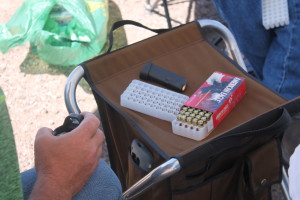
Although schools and their districts can fund themselves, Carno said FASTER recognizes that most districts don’t budget for this kind of thing, so she fundraises to help defray the costs. With this the inaugural session, Carno is hoping word gets out and she can raise more money for future sessions, which she already has a wait list for.
Opponents such as Colorado Cease Fire, started by the father of a Columbine High School shooting victim, argue more guns in schools is not the answer.
However, Colorado laws already allow school districts to contract with armed security personnel. Many districts in Colorado have expanded that to include teachers and other staff. Bennett School District in Bennett for example, creates a separate contract with any staff member who qualifies for $1. The contracts specify the responsibilities in detail of the both the staff member and the school district. They are usually year-to-year and require on-going training in handgun use and safety. Muller said Fleming will do the same thing.
The course includes everything from gun safety and how to handle an active shooter, to crisis management and first aid.
“One of the most important things I’ve learned is the crisis management,” said Ronnie Wilson, another participant who is currently in the process of starting a charter school in the Colorado Springs area. “The trauma doctor who was here and all the trainers that were here have been highly qualified and experts in their field.”
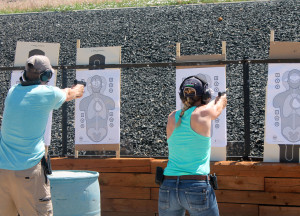
Wilson said they talked about situations that didn’t involve guns.
“So learning how to treat wounds is something that I’ve never been trained on,” Wilson said. “And I see the value of that for all school staff because you can have an accident of some kind at a school that may not even involve the type of situations were being trained for here.”
He said he chose to allow his staff to arm because prospective parents to his school are asking about security just as much as they are asking about curriculum.
FASTER’s ROOTS —
Carno learned of FASTER through a friend, Sean Maloney, and then decided to bring it to Colorado after she saw it in action in Ohio. The idea was born out of the Sandy Hook shooting.
Maloney, co-founder of FASTER and part of the Ohio-based Buckeye Firearms Association, said he was on a football recruiting trip with his son when his phone rang off the hook from others as Sandy Hook played out on national TV.
He and his colleagues knew they had to do something, he said, and he thought about a seminar he had recently attended and the words of the speaker, Lt. Col. David Grossman, Ret.
“I don’t know an awful lot, but do know a school shooting will happen again,” Grossman said that day.
“And they do,” Maloney said. “Gun advocates know the only way to stop a bad person with a gun is with a gun. Nothing else works.”
In fact, a 2013 FBI study found that most incidents from 2000-2013 ended on the gunman’s terms. However, five incidents ended when armed individuals who were not law enforcement officers, exchanged gunfire with shooters. Three shooters were killed, one was injured and the other committed suicide. All the citizens involved had valid firearms permits.
“It was a combination of actions by citizens and/or law enforcement that ended the shootings,” the report reads. “In at least 65 (40.6%) of the 160 incidents, citizen engagement or the shooter committing suicide ended the shooting at the scene before law enforcement arrived.”
Maloney said FASTER was developed to empower schools to protect themselves from incidents such as Columbine or Sandy Hook.
“The anti-gun crowd for whatever reason pretends to think the no gun signs is going to stop somebody or that they can legislate evil out of person’s heart and soul,” Maloney said. “That is just not going to happen. If you are willing to slaughter little babies, a no gun sign isn’t going to make a difference.”
Muller agreed, adding that when Fleming begins concealed carrying this fall, it will post signs similar to the Bennett School District all over its building notifying intruders that teachers and other staff members are allowed to carry on site and some do.
“Hopefully, that will be enough so that we never have to use this training,” Muller said.
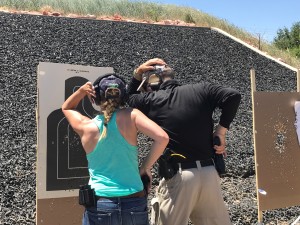
The Ohio FASTER program will have trained more than 1,000 teachers by the end of this summer. They have a waiting list much longer, Maloney said.
Buckeye brought its trainers to Colorado along with instructors from the Tactical Defense Institute, which developed the curriculum, to kick off the program. He is confident the Colorado training will expand just as it has in Ohio as parents become educated on the topic and see its success in other districts.
“FASTER came from the emotion of knowing we could do something by teaching people how to stop it, or at least to minimize the damage,” Maloney said. “When the damages are little babies and life?”
The FBI report also stated that 11 of the incidents “involved unarmed principals, teachers, other school staff and students who confronted shooters to end the threat (9 of those shooters were students).”
That fact is exactly why Maloney is passionate about arming teachers.
“I think about the 26-year-old teacher at Sandy Hook, when the only thing she had to put between the gunman and her kids was her body,” he said. “I just want to give them the chance at life.”
THE TRAINING —
The first Colorado training included both men and women and ranged from 24 to near retirement.
One woman, a 24-year-old high school teacher who asked to remain anonymous said she got her first firearm at 19 and has been training for this opportunity since.
“It’s extremely important to protect our children in school,” she said. “I’m a young female teacher. I don’t have children of my own, but I hope to one day. And I hope that if my children don’t go to my school, that they will be protected in this way.”
She said it frustrates her to hear some of her colleagues in opposition to the idea claim she can’t protect herself from a bigger, stronger student being able to disarm her.
“I know from this position, I can protect anyone of my students,” she said. “And no one can get my gun from me, should they want to.”
She said she went into the training with no expectations, and was thankful for FASTER.
“The instructors truly want the best for us,” she said. “They want us to succeed. They have exceeded everything I thought it would be. It has all been just supper beneficial.”
One of those instructors, Angela Armstrong, said it is imperative that participants get real training about active shooter scenarios so they know what to expect before they experience it.
“You have to work through different scenarios in your mind,” Armstrong said. “You’re not going to rise to the occasion, you’re going to fall to your level of training.”
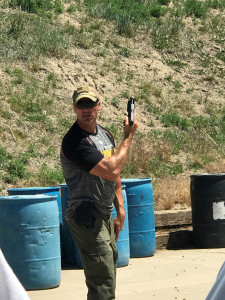
McCracken said FASTER was exactly what his district was looking for.
“The school board asked us to go above and beyond the minimum standards to be able to carry a gun on campus,” he said. “Such as what if a student tries to take our gun? There are some issues that are true concerns. Through this training and education, we are hoping to eliminate those concerns.
Armstrong said she understands this isn’t for everyone, but it should be available for those who do want it.
“You have to have the mindset,” she said. “You can put a gun in someone’s hand who is a really good shooter, but if they don’t have the mindset to pull that out and engage that lethal threat of someone coming in that school, it’s not going to work.”
Scott said he believes the training should be mandatory in all school districts for staff who wants it.
“I’m biased,” he said. “But it’s just safer. Some people will never believe that or agree with that, but it is if you’re trained and know what you’re doing.”
*Complete Colorado is a project of the Independence Institute.


